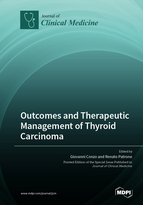Outcomes and Therapeutic Management of Thyroid Carcinoma
A special issue of Journal of Clinical Medicine (ISSN 2077-0383). This special issue belongs to the section "Oncology".
Deadline for manuscript submissions: closed (25 October 2021) | Viewed by 35633
Special Issue Editors
Interests: thyroid cancer; thyroidectomy; complications; neck dissection; local relapse; differentiated; neuromonitoring vocal folds; palsy
Special Issues, Collections and Topics in MDPI journals
2. Hepatobiliary Surgical Oncology Division, Istituto Nazionale Tumori-IRCCS-Fondazione G. Pascale, Via Mariano Semmola, 80131 Naples, Italy
Interests: thyroid cancer; endocrine surgery; thyroid surgery; oncological surgery; pancreatic surgery; pancreatic cancer, HPB surgery
Special Issues, Collections and Topics in MDPI journals
Special Issue Information
Dear Colleagues,
The impact of differentiated thyroid cancers has seen a significant increase in the world in the last decade, resulting in growth of public health spending.
Many international scientific societies are actively involved in the difficult process of building updated guidelines following the continuous news from scientific research, especially in the genetic and immunohistochemistry fields.
The watch, wait, and see policy has added a new possibility in the range of options to offer to patients in selected cases.
Considering the recognized international interest in this disease, this Special Issue aims to analyze the most recent acquisitions in terms of diagnosis and therapy of differentiated thyroid cancer.
It will offer the reader an updated point of view of the most illustrious endocrinology and endocrine-surgery international schools.
Prof. Giovanni Conzo
Dr. Renato Patrone
Guest Editors
Manuscript Submission Information
Manuscripts should be submitted online at www.mdpi.com by registering and logging in to this website. Once you are registered, click here to go to the submission form. Manuscripts can be submitted until the deadline. All submissions that pass pre-check are peer-reviewed. Accepted papers will be published continuously in the journal (as soon as accepted) and will be listed together on the special issue website. Research articles, review articles as well as short communications are invited. For planned papers, a title and short abstract (about 100 words) can be sent to the Editorial Office for announcement on this website.
Submitted manuscripts should not have been published previously, nor be under consideration for publication elsewhere (except conference proceedings papers). All manuscripts are thoroughly refereed through a single-blind peer-review process. A guide for authors and other relevant information for submission of manuscripts is available on the Instructions for Authors page. Journal of Clinical Medicine is an international peer-reviewed open access semimonthly journal published by MDPI.
Please visit the Instructions for Authors page before submitting a manuscript. The Article Processing Charge (APC) for publication in this open access journal is 2600 CHF (Swiss Francs). Submitted papers should be well formatted and use good English. Authors may use MDPI's English editing service prior to publication or during author revisions.
Keywords
- thyroid cancer
- follicular neoplasm
- thyroidectomy
- lymph node dissection
- radioiodine
- multidisciplinar approach
- thyroid microcarcinoma








